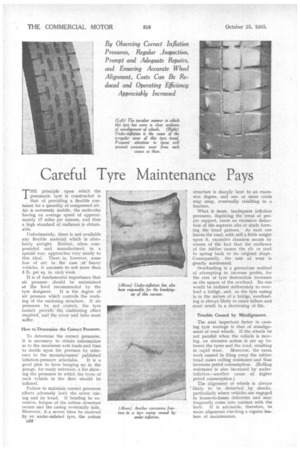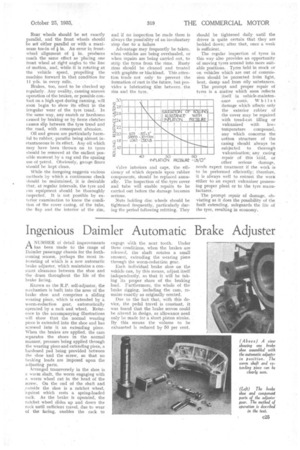Careful Tyre Maintenance Pays
Page 66

Page 67

If you've noticed an error in this article please click here to report it so we can fix it.
THE principle upon which the pneumatic tyre is constructed is that of providing a flexible container for a quantity of compressed air. Air is extremely mobile, the molecules having an average speed of approximately 17 miles per minute, and thus a high standard of resilience is obtainable.
Unfortunately, there is not available any flexible material which is absolutely airtight. Rubber, when compounded and manufactured in a special way, approaches very nearly to this ideal. There is, however, some loss of air: in the case .of heavy vehicles, it amounts to not more than 6 lb. per sq. in. each week.
It is of fundamental importance that air, pressureshould be maintained at the level recommended by the tyre designers. It is the degree of air pressure Which controls the working of the enclosing structure. If air pressures be not . correct, the tyre• cannot providethe cushioning effect required, and the cover and tube must suffer.
How to Determine the Correct Pressure.
To determine the correct pressures, it is necessary to obtain -information as to the maximum axle loads and then to decide upon the pressure by reference to the manufacturers' published
inflation-pressure schedules. It is a good plan to have hanging up in the garage, for ready reference, a list shOwing the pressures to which the tyres of each vehicle in the fleet should be inflated.
Failure to maintain correct pressures affects adversely both the cover cas-. lug and its tread. If bending be excessive, fatigue of the cotton structure
occurs and the ca,sing eventually fails. Moreover, if.a severe blow be received by. an under-inflated tyre, the cotton
c24 structure is sharply bent to an excessive degree, and one or more cords may snap, eventually resulting in a fracture.
What is more, inadequate inflation pressures, depriving the tread of proper support, cause. an excessive distortion of the separate ribs or studs forming the tread pattern. As each one leaves the road, with still a little weight upon it, excessive abrasion occurs by reason of the fact that the resilience of the rubber causes the rib or stud to spring back to its original shape. Consequently, the rate of wear is greatly accelerated.
Overloading is a precariaus method of attempting to increase profits, for the rate of tyre destruction increases as the square of the overload. No one would be inclined deliberately to overload a bridge, and, as the tyre casing is in the nature of a bridge, overloading is always likely to cause failure and must result in a shortening of life.
Trouble Caused by Misalignment.
The next important factor in causing tyre wastage is that of misalignment of road wheels. If the wheels be not parallel when the vehicle is moving, an abrasive action is set up between the tyres and the road, resulting in rapid wear. Moreover, the extra work caused in filing away the rubber. tread raises rolling resistance and thus increases petrol consumption. (Rolling resistance is also increased by underinflation—another cause of higher petrol consumption.)
The alignment of wheels is always likely to be disturbed by shocks, particularly where vehicles are engaged in house-to-house deliveries and may frequently come into contact with the kerb. It is advisable, therefore, to. make alignment checking a regular feature of maintenance.
Rear wheels ahould be set exactly parallel, and the front wheels should be set either parallel or with a maximum toe-in of in. An error in front. wheel' alignment of * in. produces much the same effect as 'placing one front wheel at right angles to the line of •motion, and; while it is rotating at the vehicle speed, propelling the machine forward in that condition for 11 yds in every mile.
Brakes, too, need to be checked up regularly. Any ovality, causing uneven operation of the brakes, or possible contact on a high spot during running, will soon begin to show its effect in the irregular wear of the tyre tread, In the same way, any snatch or harshness caused by braking or by fierce clutches causes slip between the tyre tread and the road, with consequent abrasion.
Oil and grease are particularly harmful to rubber, 'paraffin being almost instantaneous in its effect. Any oil which may have been thrown on to tyres should be removed at the earliest possible moment by a rag and the sparing use of petrol. Obviously, garage floors should be kept clean.
While the foregoing suggests various methods by which a continuous check should be maintained, it is desirable that, at regular intervals, the tyre and rim equipment should be thoroughly inspected. It is not possible by exterior examination to know the condition of the cover casing, of the tube, the flap and the interior of the rim, and if no inspection be made there is always the possibility of an involuntary stop due to a failure Advantage may frequently be taken, when vehicles are being oVerhauled, or when repairs are being carried out, to strip the tyres from the rims. Rusty rims should be cleaned and treated with graphite or blacklead. This attention tends not only to prevent the formation of rust in the future, but provides a lubricating film between the rim and the tyre..
Valve interiors and caps, the efficiency of which depends upon rubber components, should be replaced annually. The inspection of the tyre cover and tube will enable repairs to be carried out before the damage becomes serious.
Nuts holding disc wheels should be tightened frequently, particularly during the petiod following refitting. They should be tightened daily until the driver is quite certain that .they are bedded down; after that, once a week is sufficient.
The regular inspection of tyres in this way also provides an opportunity of moving tyres around into more suitable positions.. Tyres held in stock or on vehicles which are out of commission should be protected frrim light, heat, damp and from oily substances.
The prompt and proper repair of tyres is a matter which soon reflects itself in vehicle-mainten-ance costs. Whilst damage which affects only the exterior rubber of the cover may be repaired with tread-cut fining or vulcanized with lowtemperature compound, any which concerns the cotton structure of the casing should always be subjected to thorough vulcanization; any casing repair pf this kirid, or other serious damage, needs expert treatment if the work is to be performed efficiently; therefore, it is always tvell to entrust the work either to an expert vulcanizer possessing proper plant or to the tyre manufacturer.
The prompt repair of damage, obviating as it does the possibility of the fault extending, safeguards the life of the tyre, resulting in economy.
















































































































































